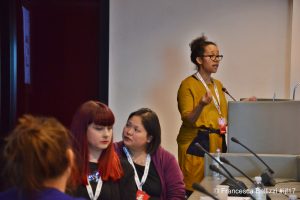In today’s digital world memes are everywhere. They not only spread all over the internet but also in everyday life. This phenomenon was the topic of the panel ‘Internet Memes: Misinformation Machines or Vectors of Truth?’ which considered the phenomena of memes in light of ever-evolving technology, misinformation and how different communities view them.
Setting a tone for the panel by using humour to reconcile a important topic, moderator Jennifer Lee the CEO and co-founder of Plympton began the discussion by exclaiming “We are determined to have the best panel that you will attend this year at IJF” and a consistent message it was, with only a few minutes later declaring “I will say hands down that we have the best slides of any presentation at the conference”.
To contextualise the discussion, Jennifer Lee defined a meme as a “digital object that is shared and remixed by multiple people”.
An Xiao Lee from Meedan, a technology company that designs tools for journalists, was the first speaker. She presented the audience with the diversity of the memes format: from the jovial Nyan Cat and Gangnam Style video remixes to activist memes such as a Chinese meme where photos were collected of people wearing sunglasses to show support to blind activist Chen Guangcheng who had disappeared. One commonality among those memes is that they reflect “cultural undercurrents”.
Demonstrating the diversity of different memes between communities and countries, An Xiao Lee showed data examining the variety and trends of animal memes by country. Questioning the assumption that “cats have taken over the internet”. This was sardonically ‘fake news’ as lamas are far more popular than cats in Latin America, hyenas reign supreme in Kenya and goats dominate in Tajikistan. Interestingly, animal memes as an occurrence have different uses, in China, animal memes and in particular lama memes are used more predominantly for activism than humour.
The next speaker, Claire Wardle from First Draft News, started her segment with a compelling case study, to explain the broader dissonance in communication online between young and older internet users. The memes that the teenagers were creating were very sophisticated, with detailed strategy discussions happening on the board around disseminating and producing their memes. This included a conversation around ensuring that their messages still have a racist undercurrent but not too racist so it can be shared more broadly.
Her presentation later moved to looking at how much harder memes were to track and understand than fake news, for example. Unlike with fake news sites where you can often just look at the URL, location of the server (such as Macedonia, a country known for being the origin of many such sites) or how recently the website was created. In a poignant statement she compared the potential illiteracy of journalists around memes to a dodgy uncle at a wedding dancing, “my worry here as journalists is how do me make sense of this without looking like we shouldn’t be there”.

Throughout her presentation, Farida Vis, the director of Visual Social Media Lab, wanted to highlight the complexities memes can present. She said that often images and memes are shared quickly to react to news events, they can “speak truth to power” and that their interpretation is quite complex. One case study she examined was the memes coming out of hurricane Katrina, although despite the events age, there had been extensive research on the area. In light of the hurricane she asked the audience to consider “What are the deeply rooted socio-economic and political reasons African Americans are seen as potential looters in the aftermath of an event like a hurricane?”
A conclusion that Vis brought to the area of memes is that journalists and social media need to move beyond their current grasp of memes. In particular, she mentioned the flagging of online content to be a superficial way of looking at memes and that instead having a “know your meme initiative for journalism” that presents context of the image to the audience.
https://soundcloud.com/user-682702853/interview-with-joanna-geary
From the Twitter Moments team, Joanne Geary, brought particular insight into how visual under-25-year-olds are becoming and understanding communities and “what they use to bond together”.
Memes, according to Geary, are not substantially different from other forms of communication. That although memes can be as “uniting as they are dividing”, most often they are simply a way to “to reinforce peoples’, sort of, joy of shared cultural happening” like for example the minor mistake in how a Del Taco restaurant advertised their avocado – “fre sha vacado”.
Like Claire, Geary pointed out the huge disparity between the communication of young and old people by documenting on Twitter the most common way that the sentence “my mum doesn’t understand…” was ended. One of the main subjects raised was “image reaction texts”.
She warned that if journalists do not engage in the visual medium significantly then journalists are not reporting for that community, the coverage around the very recent Pepsi ad was a pertinent example of that.
